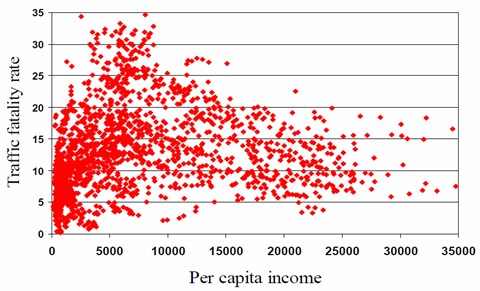
We here at Microkhan are avid fans of Robert Young Pelton’s World’s Most Dangerous Places series, in part because we never cease being amazed by the man’s utter ballsiness. (Algeria sans security in the thick of civil war? Really?) But the lure in Pelton’s work isn’t just his bravado—it’s his frankness about which travels threats are overhyped, and which should truly strike fear into a wanderer’s heart. And high atop Pelton’s list is none other than the humble minibus, the sole means of motorized transport for millions upon millions of denizens of the developing world. Such vehicles, he warns, are far more hazardous to a traveler’s health than more reviled perils such as yellow fever, thieves, or cobras. Just check out the frightening WHO statistics: 1.2 million people die each year in traffic accidents, and another 50 million are gravely injured. And the worse a nation’s roads and law enforcement are, the higher your odds of meeting a grisly end while motoring.
But what determines the lethality of a nation’s ground transport? The poorest countries are not, in fact, those with the highest traffic fatality rates, due to the fact that they have limited cars on the roads. No, the worst offenders are those nations just wealthy enough to have lots of vehicles, but poor enough that little money is spent on safety. And according to a 2006 study, things don’t get better until per-capita income exceeds $11,500 (PDF):
We argue that as a country moves through the various stages of development it can be expected that, beyond some threshold level of per capita income, increases in per capita income will tend to push down the traffic fatality rate as the rate of decline in fatalities per vehicle begins to fully offset the rising motorization rate. Regardless, for any given level of per capita income, the rate of traffic fatalities can be expected to be greater the more unequally distributed is a country’s national income both because relative inequality makes it more difficult for a society to agree on a distribution of the tax burden necessary to fund traffic safety interventions and because inequality of income causes the different segments of a society to enter the roadways in different fashions.
According to the $11,500 Rule, then, Kazakhstan must be a truly dangerous place to go a-drivin’. Can anyone confirm or deny?


fredeeky // Sep 8, 2009 at 11:25 am
wheelhouse?
http://www.boston.com/bigpicture/2009/09/two_mongolias.html
Brendan I. Koerner // Sep 8, 2009 at 1:56 pm
@fredeeky: Um, wow. Wow.
Thanks a million for the tip. I particularly dug the photo of the Jugderdemidiyn Gurragchaa statue. I may have to do a post about him in the not-too-distant future.
Also, your blog–why was I not informed? Adding to my Circuit right now. As much in my wheelhouse as breathtaking Mongolia pics.
Diana // Sep 10, 2009 at 10:49 pm
Culture plays a part. From purely personal anecdotal experience, I would guess that the Arab world has the highest fatalities per mile of roads. I’ve never been in a car or bus in the Middle East where the driver did not drive like a bat out of hell, except in Jordan (which is the only country with yellow and white solid and dotted lines painted on their roads — evidently Egypt and Syria do not bother on the grounds that the drivers won’t pay any attention.)
And Israel is no exception to the rule.
Brendan I. Koerner // Sep 11, 2009 at 4:06 pm
@Diana: Yeah, there are certain countries where reckless driving is the absolute norm. One of my most terrifying traffic moments ever came on the back of a scooter going the wrong way down a busy Delhi street. When the guy made the turn to go that way, I thought he was bluffing just to get a rise out of me. But he did it like it was the most natural thing in the world.
That raises the question, though–why do certain societies develop such reckless driving habits?